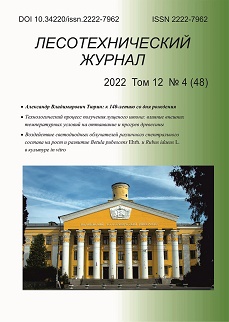Voronezh, Voronezh, Russian Federation
Voronezh, Voronezh, Russian Federation
Voronezh, Russian Federation
Russian Federation
from 01.01.2019 until now
Various types of vegetation were tested on the dumps of the Kursk magnetic anomaly (KMA), composed of various rocks and their mixtures, with the improvement of forest growing conditions by land use and without this technique, including five types of shrubby species: sea buckthorn (Hippophae rhamnoides L.), siberian peashrub (Caragana arborescens Lam.), golden currant (Ribes aureum Pursh.), tatarian honeysuckle (Lonicera tatarica L.) and red elderberry (Sambucus racemosa L.). Growth indicators, safety and productivity of breeds were studied. Golden currant was one of the first to be tested, which turned out to be an unsuitable breed for creating protective plantings on dumps without measures to improve their forest growing conditions. On chalk-marl mixtures and quaternary loams, it completely fell out by the age of 12-15 years. Shrubs used in forest reclamation on two-component post-technogenic areas are characterized by different preservation. By the age of 43, the greatest preservation, equal to 50.5%, was noted in the sea buckthorn. It also has the highest growth rates. When choosing shrub species for forest reclamation, it is necessary to take into account their biological productivity, which increases the concentration of nutrients in the substrates and improves their physical properties. The sea buckthorn at the age of 9 has a large phytomass (2368 g), the heaviest leaf mass (396 g) and a total supply of phytomass (143.9 kg /ha) in the stand. The authors recommend using shrub species for laying preliminary crops at the initial stage of reclamation or introducing them into complex plantings in an amount of no more than 50%. Taking into account the soil-improving role of shrub species, it would be advisable to further introduce more durable tree species.
biological reclamation, post-technogenic areas, perennial shrubs, siberian peashrub (Caragana arborescens Lam.), biomass
1. Bazilevich N. I. Biologicheskaya produktivnost' ekosistem Severnoj Evrazii. [Biological productivity of ecosystems of Northern Eurasia.]. Institute of Geography of the Russian Academy of Sciences. Academic scientific-publishing, production-printing and book publishing center of the Russian Academy of Sciences "Publishing "Science". 1993:293. ISBN 5-02-003731-1. (In Russ.). URL: https://elibrary.ru/item.asp?id=27226558 EDN: https://elibrary.ru/WXUTTB
2. Bachurina A. V., Zalesov S.V., Tolkach O.V. Effektivnost' lesnoj rekul'tivacii narushennyh zemel' v zone vliyaniya medeplavil'nogo proizvodstva [Efficiency of forest recultivation of disturbed land in the zone of influence of copper smelting]. Ekologiya i promyshlennost' Rossii. 2020; 6: 67-71. (In Russ.). DOI https://doi.org/10.18412/1816-0395-2020-6-67-71 EDN: https://elibrary.ru/DRXWMX
3. Goleusov P. V. Novoobrazovannye pochvy otvala ryhloj vskryshi OAO "Lebedinskij GOK". [Newly formed soils left loose in open pit of "Lebedinsky GOK"]. Problemy prirodopol'zovaniya i ekologicheskaya situaciya v Evropejskoj Rossii i na sopredel'nyh terri-toriyah: Materialy VII Mezhdunarodnoj nauchnoj konferencii (pamyati prof. Petina A.N.), Belgorod, 24-26 oktyabrya 2017 goda. - Belgorod: Izdatel'stvo «POLITERRA». 2017: 122-125. (In Russ.). URL: https://www.elibrary.ru/item.asp?id=32353429 EDN: https://elibrary.ru/YNEYXW
4. Dmitrakova YA. A., Abakumov E.V. Vosstanovlenie pochvenno-rastitel'nogo pokrova na uchastkah rekul'tivacii Kingiseppskogo mestorozhdeniya fosforitov. [Restoration of land cover at the Kingisepsky phosphate recovery sites]. Pochvovedenie = Eur. Soil Sc. 2018; 5:630-640. (In Russ.). DOI: https://doi.org/10.7868/S0032180X18050118 EDN: https://elibrary.ru/UPGFKG
5. Kapel'kina L. P., Kachubej A.A. Osvoenie nedr Sibiri i rekul'tivaciya narushennyh zemel'. [Development of the Siberian Interior and Restoration of Disturbed Lands]. Pochvy v bio-sfere: Sbornik materialov Vserossijskoj nauchnoj konferencii s mezhdunarodnym uchastiem, posvyashchen-noj 50-letiyu Instituta pochvovedeniya i agrohimii SO RAN, Novosibirsk, 10 - 14 sentyabrya 2018 g. Novo-sibirsk: Nacional'nyj issledovatel'skij Tomskij gosudarstvennyj universitet. 2018: 321-325. (In Russ.). URL: https://www.elibrary.ru/item.asp?id=35522909 EDN: https://elibrary.ru/XXWVLV
6. Kishtanov B. V. Ispol'zovanie smorodiny zolotoj v zashchitnom lesorazvedenii na territorii Respubliki Kalmykiya. [Use of golden currant in protective forestry in the territory of the Republic of Kalmykia]. Nauchno-agronomicheskij zhurnal. 2022; 1(116):5-10. (In Russ.). DOI https://doi.org/10.34736/FNC.2022.116.1.001 EDN: https://elibrary.ru/NCFUEO
7. Kostina E.E., Ahmetova G.V., Pekkoev A.N., Haritonov V.A., Kryshen' A.M. Formirovanie rastitel'nogo pokrova pri lesnoj rekul'tivacii peschano-gravijnogo kar'era v Respublike Kareliya. [Formation of vegetation under forest recultivation of sand and gravel quarry in the Republic of Karelia]. Rastitel'nye resursy. 2022; 3:290-310. (In Russ.). DOI https://doi.org/10.31857/S0033994622030074 EDN: https://elibrary.ru/FZJYNM
8. Lihanova I. A., Kovaleva V.A. Odnovremennyj posev lugovyh zlakov i posadka drevesnyh rastenij v hode lesnoj rekul'tivacii narushennyh zemel' v severnoj tajge Respubliki Komi. [Simultaneous sowing of grasses and planting of woody plants during forest recultivation of disturbed lands in the northern taiga of the Komi Republic]. Lesovedenie. 2018; 6: 444-453. (In Russ.). DOI https://doi.org/10.1134/S0024114818060050 EDN: https://elibrary.ru/YLRXBB
9. Malinina T.A., Golyadkina I.V., Tihonova E.N., Dedenko T.P. Ocenka vodno-fizicheskih svojstv tekhnogennyh substratov pri biologicheskoj rekul'tivacii otvalov KMA. [Assessment of water-physical properties of technogenic substrates during biological recovery of KMA dumps]. Lesotekhnicheskij zhurnal = Forestry Engineering Journal. 2022; 1(45):44-55. (In Russ.). DOI https://doi.org/10.34220/issn.2222-7962/2022.1/4 EDN: https://elibrary.ru/MDQVUG
10. Pigorev I. YA., Lezhnina A.V. Vlagozapasy v porodah tekhnogennogo landshafta. [Water reserves in the rocks of technogenic landscape]. Problemy ekologizacii sel'skogo hozyajstva i puti ih resheniya: materialy nacional'noj nauchno-prakticheskoj konferencii, Bryansk, 09 noyabrya 2017 goda. - Bryansk: Bryanskij gosudarstvennyj agrarnyj universitet. 2017:23-25. (In Russ.). URL: https://www.elibrary.ru/item.asp?id=30530373 EDN: https://elibrary.ru/ZSCMTD
11. Prutskoj A. V. Osobennosti stroeniya kornevyh sistem sosny obyknovennoj i duba chereshchatogo v hvojno-shirokolistvennyh nasazhdeniyah na supeschanoj podzolistoj pochve. [The structure of the roots systems of scots pine and pedunculate oak in coniferous-broad-leaved stands on the podzolic soil.] Uspekhi sovremennogo estestvoznaniya. 2017; 7:47-53. (In Russ.). URL: https://www.elibrary.ru/item.asp?id=29771754 EDN: https://elibrary.ru/ZBMWOP
12. Stifeev A.I., Nikitina O.V., Nagornaya O.V. Osnovnye napravleniya preobrazovaniya tekhnozemov v kul'tur-nye landshafty. [Main directions for the transformation of technosomes into cultural landscapes]. Vestnik Kurskoj gosudarstvennoj sel'skohozyajstvennoj akademii. 2019; 3:28-34. (In Russ.). URL: https://www.elibrary.ru/item.asp?id=38249929 EDN: https://elibrary.ru/ZTQBWX
13. Treshchevskaya E.I., Tihonova E.N., Golyadkina I.V., Treshchevskaya S.V., Knyazev V.I. Karagana drevovidnaya (Caragana arborescens Lam.) kak kustarnikovaya poroda pri biologicheskoj rekul'tivacii tekhnogennyh landshaftov. [Caragana arborescens Lam. as a shrub species at biological reclamation of technogenic landscapes]. Lesotekhnicheskij zhurnal = Forestry Engineering Journal. 2021; 3 (43):31-44. (In Russ.). DOI: https://doi.org/10.34220/issn.2222-7962/2021.3/3 EDN: https://elibrary.ru/OEFOYD
14. Treshchevskaya E. I., Tihonova E.N., Malinina T.A., Golyadkina I.V. Ispol'zovanie oblepihi krushinovoj (Hippophae rhamnoides L.) dlya lesnoj rekul'tivacii tekhnogennyh landshaftov. [The use of Hippophae rhamnoides L. for forest reclamation of technogenic landscapes]. Lesotekhnicheskij zhurnal = Forestry Engineering Journal. 2018;3 (31): 108-115 (In Russ.). DOI: https://doi.org/10.12737/article_5b97a167eee7e8.90796737 EDN: https://elibrary.ru/YQVSXZ
15. Ufimcev V. I., Androhanov V.A. Osobennosti nakopleniya fitomassy v lesnyh nasazhdeniyah na otvalah Listvyanskogo ugol'nogo razreza. [Peculiarities of phytomassa accumulation in forest plantations on the tailings of Listvyanskogo coal section].Nauchnye izvestiya 2022; 29:152-157. (In Russ.). URL: https://www.elibrary.ru/item.asp?id=49455138 EDN: https://elibrary.ru/DHMKHD
16. Hamarova Z. H., Aliev I.N. Osnovnye napravleniya biologicheskoj rekul'tivacii tekhnogennyh landshaftov v Kabardino-Balkarii. [Main directions of biological reclamation of man-made landscapes in Kabardino-Balkaria]. Vestnik Altajskogo gosudarstvennogo agrarnogo universiteta. 2016; 5(139): 67-7. (In Russ.). URL : https://www.elibrary.ru/item.asp?id=26177982
17. YAkimov N. Osvoenie lesnymi kul'turami narushennyh zemel' respubliki. [Development of disturbed lands by forest crops.]. Zemlya Belarusi. 2017;1: 39-41. (In Russ.). URL:https://www.elibrary.ru/item.asp?id=44311897 EDN: https://elibrary.ru/SUUGMW
18. Festin E.S., Tigabu M., Chileshe M.N. et al. Progresses in restoration of post-mining landscape in Africa. J. For. Res. 2019;30:381-396 DOI: https://doi.org/10.1007/s11676-018-0621-x EDN: https://elibrary.ru/ICPGSR
19. Pietrzykowski M. Tree species selection and reaction to mine soil reconstructed at reforested post-mine sites: Central and eastern European experiences. Ecological Engineering. 2019;3:100012. DOI: https://doi.org/10.1016/j.ecoena.2019.100012
20. Li X., Lei S., Cheng W. et al. Spatio-temporal dynamics of vegetation in Jungar Banner of China during 2000-2017. J. Arid Land 2019;11:837-854. DOI: https://doi.org/10.1007/s40333-019-0067-9
21. Liu S., Liu L., Li J., Zhou Q., Ji Y., Lai W., Long C. Spatiotemporal Variability of Human Disturbance Impacts on Ecosystem Services in Mining Areas. Sustainability 2022;14:7547. DOI: https://doi.org/10.3390/su14137547 EDN: https://elibrary.ru/DNPBVB
22. Macdonald S, Landhausser S., Skousen J., Franklin J., Frouz J., Hall S., Jacobs D., Quide S. Forest restoration following surface mining disturbance: challenges and solutions. New Forests. 2015:703-732. DOI: http://dx.doi.org/10.1007/s11056-015-9506-4 EDN: https://elibrary.ru/AMPVNR
23. McMahen K, Simard S, Grayston S, Anglin L, Lavkulich L. Small-volume additions of forest topsoil improve root symbiont colonization and seedling growth in mine reclamation. Applied Soil Ecology. 2022 DOI: https://doi.org/10.1016/j.apsoil.2022.104622 EDN: https://elibrary.ru/ETFNRS
24. Sarah N. Brown, Rebecca M. Swab. To Establish a Healthy Forest: Restoration of the Forest Herb Layer on a Reclaimed Mine Site," The American Midland Naturalist 2021;186(1):35-50. DOI: https://doi.org/10.1674/0003-0031-186.1.35
25. Soriaa R., Rodríguez-Berbela N., Ortegaa R., Lucas-Borjab M.E., Mirallesa I. Soil amendments from recycled waste differently affect CO₂ soil emissions in restored mining soils under semiarid conditions Journal of Environmental Management. 2021; 294: 112894. DOI: https://doi.org/10.1016/j.jenvman.2021.112894 EDN: https://elibrary.ru/MASBKX
26. Wu Z., Li H., Wang Y. Mapping annual land disturbance and reclamation in rare-earth mining disturbance region using temporal trajectory segmentation. Environ Sci Pollut Res 2021;28:69112-69128. DOI: https://doi.org/10.1007/s11356-021-15480-3
27. Yang W., Mu Y., Zhang W., Wang W., Liu J., Peng J., Liu X., He T. Assessment of Ecological Cumulative Effect due to Mining Disturbance Using Google Earth Engine. Remote Sens. 2022;14:4381. DOI: https://doi.org/10.3390/rs14174381 EDN: https://elibrary.ru/FOUBFH
28. Wang Z., Lechner A.M., Yang Y., Baumgartl T., Wu J. Mapping the cumulative impacts of long-term mining disturbance and progressive rehabilitation on ecosystem services. The Science of the total environment. 2020;717: 137214.DOI: https://doi.org/10.1016/j.scitotenv.2020.137214












